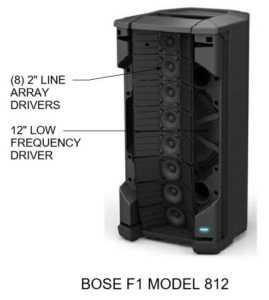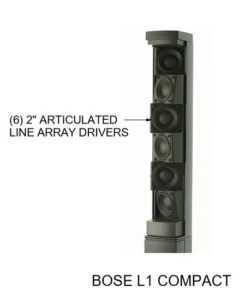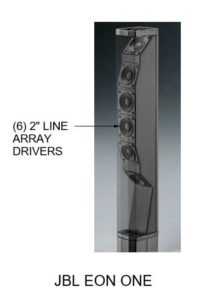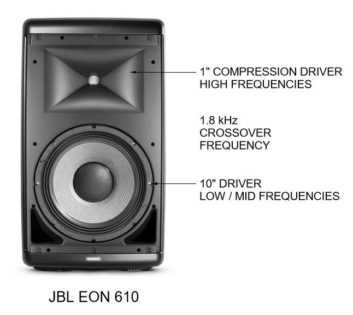
Which Is Better: Compact Line Array or Regular Two-Way PA Speakers?
Lately more and more speaker manufacturers are introducing their own compact line array powered speaker designs. I switched to this type of speaker six years ago and haven’t looked back! I’ve been more than happy with the sound reproduction and so have my audiences. One reason for my happiness is the ease of setup and extreme portability inherent with this type of system; however, your standard powered PA speakers can also be easy to setup and are getting extremely portable as well. In this article I will briefly explain the fundamentals of each type of speaker. I’ll also analyze the pros and cons of each as we see who wins the battle of compact line array vs regular speakers.



Compact Line Array Speakers
Bose started the latest trend of compact line array speakers in 2003 with the L1 system. This system was originally called the personal amplification system, but it ultimately became known as the L1 portable line array. In 2009 Bose released the L1 Compact and revolutionized compact line array speaker design yet again with a smaller, powered, portable speaker. The line array arrangement used in these speakers is simply a series of small speakers in a line. Bose’s proprietary arrangement tilts each speaker in alternating directions to maximize the horizontal coverage of the system. This arrangement of the line array yields an amazing 180 degrees of horizontal coverage. Bose’s L1 systems utilize 2″ speaker drivers for both high and mid frequency sound. Other manufacturer’s systems utilize other sizes of speakers in a similar linear arrangement. The resulting line array is typically mounted above a powered subwoofer built into an enclosure. Bose, JBL and other manufacturers have also integrated their own proprietary line array speaker stand extensions which neatly mount in the base unit, support the line array and provide internal speaker wiring for a neat, easy to setup package. The sound characteristics of line array systems are also unique. Since the high and mid frequencies are both delivered through the line array, a smooth, present mid range tone as well as crisp sibilant highs are reproduced. The crossover point from sub to mid is typically somewhere around 400 Hz. This means the larger driver within the subwoofer is only handling bass frequencies as should be the case. The resulting sound of the entire system is more evenly distributed across the entire frequency range.


Regular PA Speakers
In the early years of my singing career I owned numerous regular speakers. These regular PA speakers consist of a single large speaker for low and mid range frequencies accompanied by a single horn coupled to a high frequency compression driver for high frequency sounds. These speakers are nowadays typically powered speaker enclosures. The crossover points in these two way speaker enclosures range from 1.5 kHz to 3.5 kHz. If these regular PA speakers are used with a subwoofer in a 3-way arrangement, the crossover for the sub is typically set between 80 Hz and 120 Hz. An examination of the crossover points in the two-way configuration tells us that mid range sound would be somewhat lacking in this arrangement because a large speaker would be responsible for all frequencies up to 1.5 kHz or greater. This is due to the fact that high frequency compression drivers aren’t made for mid range frequencies. The result is a speaker less capable of reproducing mid ranged frequencies. Another characteristic typical of regular speakers is a harshness to the high frequencies reproduced. The horns and high frequency compression drivers throw high frequencies great distances into the crowd, but they tend to be less pleasant to the ear. This system can be advantageous when reproducing pounding bass (with a subwoofer) and sibilant rhythmic sounds. This type of speaker can also be more beneficial in larger venues where volume and power is required.
Compact Line Array Speakers
| Pros | Cons |
|---|---|
| Portability | Less Low End Power |
| Easy Setup | |
| Excellent Mid-Range Sound Reproduction | |
| More Even Frequency Response Across the Spectrum | |
| Wider Horizontal Coverage | |
| More Built-In Features in All-In-One Systems |
Regular 2-Way PA Speakers
| Pros | Cons |
|---|---|
| More Low End Power | Bulkier, Heavier Components |
| Better High Frequency Throw for Larger Venues and Outdoor Events | More Complex Setup |
| Poor Mid-Range Sound Reproduction | |
| Narrow Horizontal Coverage |

The Verdict: I Prefer Compact Line Array Over Regular PA Speakers
A close look at compact line array vs regular speakers reveals a weakness in the mid-range frequency reproduction of the regular speakers. It also points to harsher high frequencies that may throw a greater distance, but are less pleasant to the ear than those delivered by compact line array speakers. This is why I find my vocals are more present when reproduced by my compact line array system versus my old regular two-way PA speakers. Another reason I believe compact line array designs have the edge over regular speakers is due to their superior horizontal coverage. This is most evident in Bose’s L1 and L1 Compact line array designs. Another edge I give to compact line array speakers is that they tend to be more portable and easier to setup due to designs that integrate speaker wiring with the elevated line array supports. Regular PA Speakers require the use of separate speaker stands and cables to support them in a similar fashion. Further study reveals that many compact line array systems also include a more robust mixer section, allowing for more channels, effects, bluetooth and even wireless control. It’s now obvious to me that compact line array speakers are superior to regular PA speakers because of their smooth mids and highs, portability, enhanced coverage and ever growing capabilities. The end goal is to deliver a great sound, in the most efficient fashion… isn’t it?